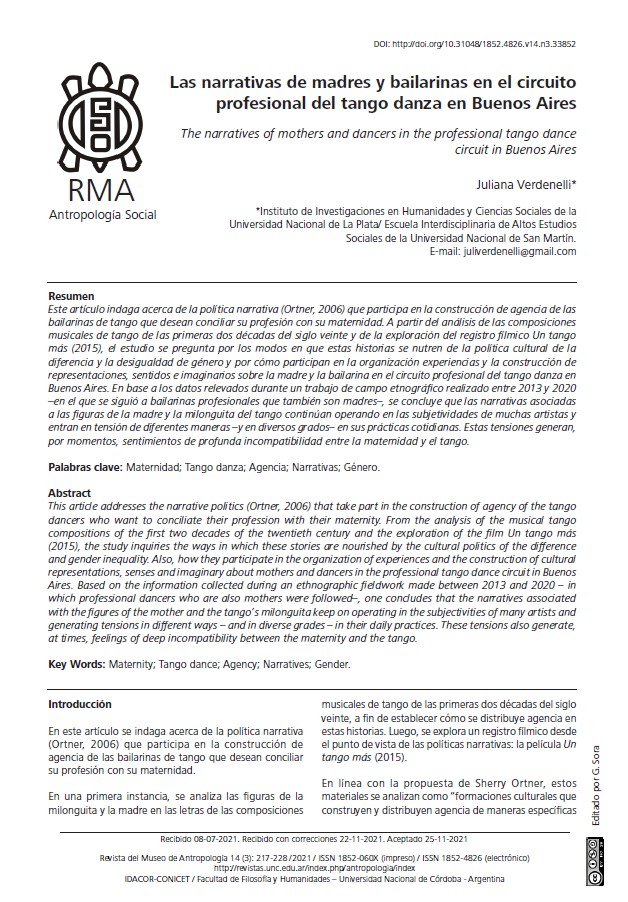The narratives of mothers and dancers in the professional tango dance circuit in Buenos Aires
DOI:
https://doi.org/10.31048/1852.4826.v14.n3.33852Keywords:
Maternity, Tango dance, Agency, Narratives, GenderAbstract
This article addresses the narrative politics (Ortner, 2006) that take part in the construction of agency of the tango dancers who want to conciliate their profession with their maternity. From the analysis of the musical tango compositions of the first two decades of the twentieth century and the exploration of the film Un tango más (2015), the study inquiries the ways in which these stories are nourished by the cultural politics of the difference and gender inequality. Also, how they participate in the organization of experiences and the construction of cultural representations, senses and imaginary about mothers and dancers in the professional tango dance circuit in Buenos Aires. Based on the information collected during an ethnographic fieldwork made between 2013 and 2020 – in which professional dancers who are also mothers were followed–, one concludes that the narratives associated with the figures of the mother and the tango’s milonguita keep on operating in the subjectivities of many artists and generating tensions in different ways – and in diverse grades – in their daily practices. These tensions also generate, at times, feelings of deep incompatibility between the maternity and the tango.
Downloads
References
Archetti, Eduardo (2003). Masculinidades. Fútbol, tango y polo en la Argentina. Buenos Aires: Antropofagia.
Armus, Diego (2002). “‘Milonguitas’ en Buenos Aires (1910- 1940): tango, ascenso social y tuberculosis”. En História, Ciências, Saúde Manguinhos (9), 87- 207.
Blázquez, Gustavo (2014). ¡Bailaló! Género, raza y erotismo en el Cuarteto Cordobés. Buenos Aires: Gorla.
Campodónico, Raúl Horacio y Fernanda Gil Lozano (2000). “Milonguitas en-cintas: la mujer, el tango y el cine”. En F. Gil, V. Pita y M. Gabriela Ini (eds.) Historia de las mujeres en la argentina 2. Siglo XX. Buenos Aires: Taurus, 117- 136.
Carozzi, María Julia (2014). “Lo sexual es invisible a los ojos: exhibición erótica y ocultamiento de los vínculos sexuales en las milongas céntricas de Buenos Aires”. En Versión. Estudios de Comunicación y Política. Nueva Época (33), 105- 118.
Carozzi, María Julia (2015). Aquí se baila el tango. Una etnografía de las milongas porteñas. Buenos Aires: Siglo XXI Editores.
Cosse, Isabella (2010). Pareja, sexualidad y familia en los años ’60. Buenos Aires: Siglo XXI Editores.
Foucault, Michel (1992) [1977]. Microfísica del poder. Madrid: La Piqueta.
Gálvez, Eduardo (2009). “El tango en su época de gloria: ni prostibulario, ni orillero. Los bailes en los clubes sociales y deportivos de Buenos Aires, 1938-1959”. En Nuevo Mundo Mundos Nuevos.
Imaz, Elixabete (2010). Convertirse en madre. Etnografía del tiempo de gestación. Madrid: Cátedra.
Lamas, Hugo; Binda, Enrique (1998). El tango en la sociedad porteña (1880-1920). Buenos Aires: Héctor Lorenzo Lucci Ediciones.
Liska, Mercedes (2018). Entre géneros y sexualidades. Tango, baile, cultura popular. Buenos Aires: Milena Caserola.
Mahmood, Saba (2008). “Teoría Feminista y el Agente Social Dócil. Algunas reflexiones sobre el Renacimiento Islámico en Egipto”. En Cultural Anthropology 16 (2): 202-236.
McGannon, Kerry R.; Curtin, Kim; Schinke, Robert J.; et. al. (2012). “(De)Constructing Paula Radcliffe: Exploring media representations of elite running, pregnancy and motherhood through cultural sport psychology”. In Psychology of Sport and Exercise (13), 820-829.
Ortner, Sherry (2016) [2006]. Antropología y teoría social. Poder y agencia. Buenos Aires: Unsam Edita.
Pujol, Sergio (1999). Historia del Baile. De la Milonga a la Disco. Buenos Aires: Emecé.
Sáez, Mariana Lucía (2017). Presencias, riesgos e intensidades. Un abordaje socio-antropológico sobre y desde el cuerpo en los procesos de formación de acróbatas y bailarines/as de danza contemporánea en la ciudad de La Plata. Tesis de doctorado, Facultad de Filosofía y Letras, Universidad de Buenos Aires.
Savigliano, Marta E. (1994). “Malevos llorones y percantas retobadas: el tango como espectáculo de razas, clases e imperialismo” En Revista Relaciones de la Sociedad Argentina de Antropología. Tomo 19, 79-104.
Varela, Gustavo (2005). Mal de Tango. Buenos Aires: Paidós.
Verdenelli, Juliana (2020). Entre crear y criar: balances entre la profesión y la maternidad de bailarinas de tango y bailarinas de contemporáneo en Buenos Aires. Tesis de Doctorado en Antropología Social. Instituto de Altos Estudios Sociales, Universidad Nacional de San Martín.
Wainerman, Catalina (2005). La vida cotidiana en las nuevas familias. ¿Una revolución estancada? Buenos Aires: Lumiere.
Fuentes periodísticas y cinematográficas
Brufman, Melina (octubre de 2012). “La danza de la vida”. Revista El Tangauta (215), 19-26.
Guerriero, Leila (7 de mayo de 2017). “María Nieves Rego, tango de amor y odio”. Diario El País. Link: https://elpais.com/elpais/2017/05/08/eps/1494194728_149419.html
Un Tango más (2015). Ficha Técnica del Documental: Dirección: Germán Kral. Producción ejecutiva: Wim Wenders. Guion: Germán Kral y Daniel Speck. Música: Luis Borda, Sexteto Mayor y Gerd Baumann. Reparto: María Nieves Rego, Juan Carlos Copes, Pablo Veron, Alejandra Gutty, Ayelén Álvarez Miño y Juan Malizia.

Downloads
Published
Issue
Section
License
Copyright (c) 2021 Juliana Verdenelli

This work is licensed under a Creative Commons Attribution-NonCommercial-ShareAlike 4.0 International License.
Those authors who have publications with this Journalaccept the following terms:
a. Authors will retain their copyrights and guarantee the journal the right of first publication of their work, which will be simultaneously subject to the Creative Commons Attribution License (Licencia de reconocimiento de Creative Commons) that allows third parties to share the work as long as its author and his first publication in this journal.
b. Authors may adopt other non-exclusive licensing agreements for the distribution of the version of the published work (eg, deposit it in an institutional electronic file or publish it in a monographic volume) provided that the initial publication in this journal is indicated.
c. Authors are allowed and recommended to disseminate their work on the Internet (eg in institutional telematic archives or on their website) before and during the submission process, which can lead to interesting exchanges and increase citations of the published work. (See The Effect of Open Access - El efecto del acceso abierto)











